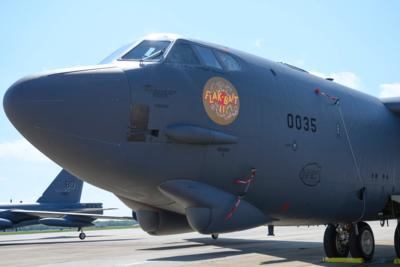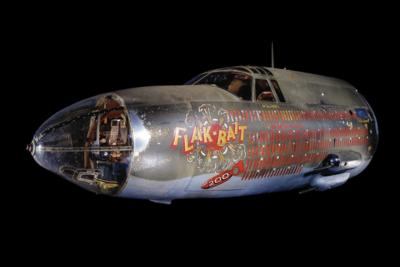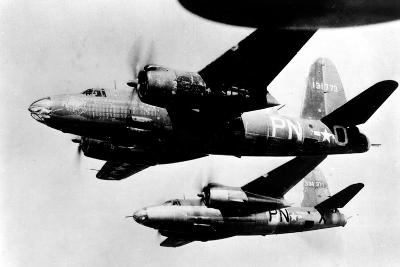B-52 Stratofortress Named After The Record-Setting B-26
When World War II ended in 1945, a Martin B-26 Marauder named Flak-Bait had flown 207 missions — more than any other U.S. plane in the conflict. But its achievement was lost to history until three Barksdale Air Force Base crew chiefs named a B-52 Stratofortress after the record-setting B-26.

Flak-Bait lived up to its name during the war. It sustained hits on almost every mission, once having its hydraulics shot out, and twice losing its electrical system to German 88mm guns. On two other sorties, it returned home on only a single engine. By war’s end, the bomber endured more than 1,000 strikes. Not a single panel on it had gone unscathed.
After the war, it was disassembled and shipped in crates to the National Air and Space Museum’s storage facility in Washington D.C. It remained in storage for decades, its name and history largely forgotten to current generations of bomber aircrew.
That is until Senior Airman Joshua Rich, an 11th Aircraft Maintenance Unit crew chief, stumbled across the name. Rich and his fellow 307th Aircraft Maintenance Squadron crew chiefs, Staff Sgt. William Etheridge and Tech. Sgt. Patrick Deslauriers, were in charge of a newly repainted B-52 and searching for a new name for it.
They started brainstorming and Rich inadvertently offered the name Flak-Bait, unaware of the B-26 and its history. Rich could not account for how he thought of the name.
“It was something that was just in my head,” he explained. “I was a big airplane buff as a kid, so maybe it was something I read about in my childhood.” An internet search of the name opened up the crew chief’s eyes to the history of the bomber. They were hooked. “We knew this was the name we wanted; we needed to preserve its heritage,” Etheridge said.

The Airmen decided to name the B-52 Flak-Bait II and re-create the nose art of the original plane. None of them had ever renamed a jet, and the name choice created some steps not found in the usual process.
The crew chiefs decided to contact the Smithsonian Air and Space Museum to see if they needed permission to use the name. They did not and the museum curator expressed enthusiasm for the idea. Smithsonian officials directed Etheridge to Roberta Dow-Faulkenberry, a secretary at the B-26 Marauder Historical Society, for help in recreating Flak-Bait’s nose art. Dow-Faulkenberry had studied Flak-Bait’s history since 1980. She has, by her estimation, completed several hundred hours of research on the bomber. She was happy to help when Etheridge reached out to her.
“It’s amazing that we are actually bringing our first-generation aircrew back into the light,” she said. “There aren’t very many of them left.” Flak-Bait II also helped the society solve a problem they had wrestled with for some time.
“We were always discussing ways to bring our society into the future and tell our story to third and fourth generation aircrew,” Dow-Faulkenberry explained. “This was a big step in doing that.” With the help of Smithsonian officials and Dow-Faulkenberry, the crew chiefs began the task of recreating the original nose art, a process that took nearly six months.

Delays and efforts to recreate the nose art brought the process to a slow grind, but the group refused to give up. Etheridge persevered and was able to re-create the artwork and get it approved. But some aircrew, unfamiliar with the plane’s history, viewed the name with skepticism. Etheridge smiled when recalling their reaction to the name. Once they heard the original Flak-Bait had sustained over 1,000 hits without ever going down, the aircrew’s reaction changed.
“They all said, ‘we want Flak-Bait, that’s what we want!’,” Etheridge said.
Preservation of the original Flak-Bait started a few years ago at the Mary Baker Engen Restoration Hangar at the National Air and Space Museum’s Udvar-Hazy Center in Chantilly, Virginia. An idea to showcase Flak-Bait and Flak-Bait II together was floated, but the B-52 was too large to maneuver the center’s flight line.
Still, Flak-Bait II now shares a common name and heritage with the older bomber. “We call it our big, little sister,” said Dow-Faulkenberry. She expressed hope that other bombers in the current and future Air Force inventory might be named after other Marauders. Time will tell what becomes of that idea, but one thing is certain. The spirit of Flak-Bait is alive and well at Barksdale AFB.
(ANN salutes Master Sgt. Ted Daigle, 307th Bomb Wing for this story)
 ANN's Daily Aero-Linx (04.30.25)
ANN's Daily Aero-Linx (04.30.25) ANN FAQ: Turn On Post Notifications
ANN FAQ: Turn On Post Notifications Classic Aero-TV: Agile Aeros Jeff Greason--Disruptive Aerospace Innovations
Classic Aero-TV: Agile Aeros Jeff Greason--Disruptive Aerospace Innovations Aero-News: Quote of the Day (04.30.25)
Aero-News: Quote of the Day (04.30.25) ANN's Daily Aero-Term (04.30.25): Expedite
ANN's Daily Aero-Term (04.30.25): Expedite





